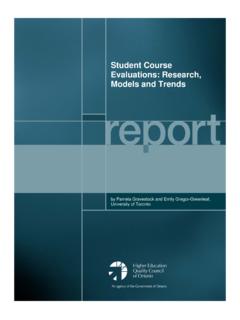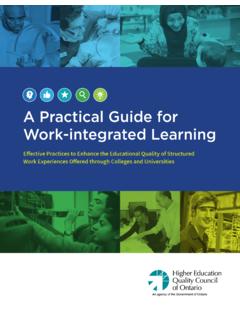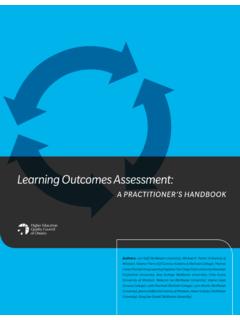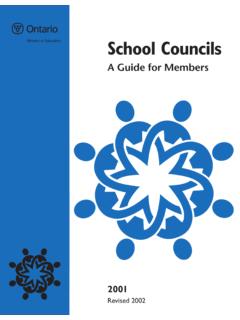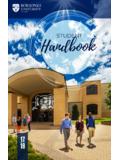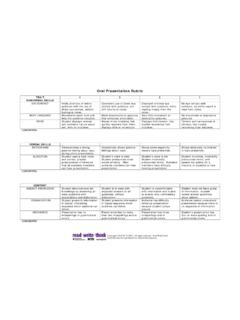Transcription of S nt Services - HEQCO
1 S Suppor rting StPretudent Swithiepared by TSuccesn OntaTricia A. Sess: The rio s Poifert, Christfor the Hig Role oostsecotine Arnold,gher Educaof Studeondary, Jeff Burrowtion Qualityent Sery Instituw and Angey Council ofrvices utions el Brown f Ontario Disclaimer: The opinions expressed in this research document are those of the authors and do not necessarily represent the views or official polices of the Higher Education Quality Council of Ontario or other agencies or organizations that may have provided support, financial or otherwise, for this project. Cite this publication in the following format: Seifert, , Arnold, C., Burrow, J., Brown, A. Supporting Student Success: The Role of Student Services within Ontario s Postsecondary Institutions.
2 Toronto: Higher Education Quality Council of Ontario. Published by: The Higher Education Quality Council of Ontario 1 Yonge Street, Suite 2402 Toronto, ON Canada M5E 1E5 Phone: (416) 212-3893 Fax: (416) 212-3899 Web: E-mail: Queens Printer for Ontario, 2011 1 Supporting Student Success: The Role of Student Services within Ontario s Postsecondary Institutions Table of Contents Executive Summary .. 3 Introduction .. 7 Review of Literature .. 8 Methodology .. 10 Sample: Institutions .. 10 Sample: Participants .. 12 Data Collection .. 13 Data Analysis .. 14 Results .. 15 Part I. Description of Formal Organizational Structures in SAS Divisions .. 15 Titles and Reporting Lines of SSASO .. 16 Portfolio of SAS Divisions .. 17 Registrar .. 16 Residence.
3 18 Athletics and Recreation .. 19 Dynamic Nature of SAS Divisions .. 20 Part II. Staff Perceptions of Organizational Structures .. 21 Relating Imagery of Spider Webs and Silos to Approaches to Structure .. 21 Spider Webs .. 21 Silos .. 25 Recognizing the Continuum between Student-focused and Institution-focused .. 26 Tension between Two Divisions within the Institution .. 16 Tension between Two Departments within the SAS Division .. 26 Tension between Individual SAS Staff Members .. 27 Types of Organizational Structure .. 28 Approach to Structure Yields Different Informal Organizational Structures .. 30 Intentional Communication Strategies .. 30 Collaborating for Improvemenet and Innovation .. 31 Levers that Influence Formal and Informal Structures of SAS Divisions.
4 32 Changing Demographics of students and Increased Enrolments .. 32 Governmental and External Initiatives and Funding Envelopes .. 33 Resources: A 'Have' vs. 'Have Not' Dilemma .. 34 Discussion and Implications of Findings .. 36 Changing Approaches to Structure Comes with a Change in Culture .. 37 Think Intentionally about Using Funding to Grow Division and Mandate .. 38 Developing Staff to be Excellent Service Providers AND Educators .. 39 2 Supporting Student Success: The Role of Student Services within Ontario s Postsecondary Institutions Collaborating Broadly Best Meets Student Needs .. 41 References .. 44 Appendix A.. 48 Appendix B .. 49 Appendix C .. 50 Appendix D .. 52 Acknowledgements .. 53 3 Supporting Student Success: The Role of Student Services within Ontario s Postsecondary Institutions Executive Summary Canada is in the midst of unprecedented growth in the postsecondary education (PSE) sector.
5 More students are availing themselves of college and university educational opportunities than at any other time in the nation s history. The students now enrolling bring a diverse set of characteristics rarely seen within the sector previously. They are immigrants, children of immigrants, first in their family to enrol in postsecondary, Aboriginal, visible minorities, and students with disabilities to name just a few. College and university programs and Services have grown to meet the needs of these increasingly diverse learners, and are largely referred to as student affairs and Services , (SAS). One of the aims of this study was to develop a greater understanding of the scope of student affairs and Services and describe the formal organizational structures of these divisions within Ontario s postsecondary sector.
6 We found no consistent title for the senior student affairs and Services officer (SSASO) across the sample; titles ranged from Vice President, Student Services to Associate Vice Principal and Dean of Student Affairs. Despite the inconsistency of title, the reporting line was fairly consistent, with SSASOs reporting to the Provost and Vice President, Academic or directly to the President. In only a few cases, dotted line reporting structures existed between the SSASO and these senior administrators. The portfolios for SSASOs tended to include new student orientation, student leadership programs and liaison with student government, campus involvement (clubs and organization recognition), community development (service learning and civic engagement initiatives), counselling Services , health Services , accessibility Services (also called Services for students with disabilities), career and employment Services (and in some cases, cooperative education), academic skills or learning Services , and Services for diverse students (such as Aboriginal student Services , international student Services , women centres, and mature student centres).
7 Portfolios differed in terms of whether the registrar s office and related enrolment management functions, residence, and athletics were included within the SSASO s portfolio. In general, we found the college SSASO s portfolios to be more expansive than the portfolios of the university SSASOs. The second aim of this study was to share the voices of the staff who work in student affairs and Services divisions across Ontario. Staff shared their perspectives regarding the organizational structure of their institution and how they perceived these organizational structures as helping or hindering their ability to support student success. Staff depicted and described two types of images that correspond with how they perceived the organizational structure of their institution. Spider webs tended to represent institutions where the staff perceived the organizational culture as one where supporting student success was a shared commitment between staff and faculty; where the SSASO s leadership style was directed toward finding the synergy between divisional areas, open to ideas from all areas within the division, and advocated for the division in senior administrative meetings; and where staff understood the vision and mission of the division as it supported and contributed to the institutional mission.
8 Silos tended to represent institutions 4 Supporting Student Success: The Role of Student Services within Ontario s Postsecondary Institutions where the staff perceived the organizational culture as one in which people worked in their discrete units and were less committed to a shared focus on supporting student success; where the SSASO s leadership style managed departments within the division more as discrete units, less open to ideas from across the division, and with greater hesitation in advocating for the division in senior administrative meetings; and where staff were less clear about how the vision and mission of the division supported and contributed to the institutional mission. This imagery was powerful in that it spoke to two different approaches to organizational structure: one was student-focused and the other was institution-focused.
9 Student-focused structures were those that aligned organizational structures (proximal location of departments, sub-unit reporting portfolios, policies and protocols) with the student in mind. Institution-focused structures were those that focused on the organization of the institution s business first, and appeared to value it over how students would encounter the institution as they worked through successful completion of their program of study. The spider web and silo imagery and their relation to the student-focused and institutional-focused approaches to structure appeared irrespective of the actual organizational structure of the institution. Institutions were typically centralized, decentralized, or federated (a combination of the two former models). A centralized structure tended to have the various units within the division (health and counselling, residence, registrar, and athletics, for example) headed by a director or manager reporting to the SSASO, and providing programs and Services for the institution as a whole.
10 Conversely, a decentralized structure was one in which programs and Services were managed and provided for within multiple institutional units, typically within the faculties. Finally, the federated structure (or hub and spoke model) was found at institutions in which programs and Services existed with some level of centralization, and customized versions of these central Services also existed at typically the individual faculty level. A critical finding from this study was that student-focused or institution-focused approaches to organizational structure could be illustrated by any of the three actual structures (centralized, decentralized, or federated). It is as possible to have a student-focused approach with a federated SAS structure as it is to have an institution-focused approach with a centralized SAS structure.
